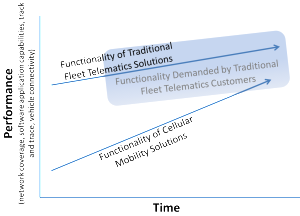Fleet Telematics Competition Benefits Customers
by
If your firm uses a legacy telematics system to manage its fleet, it may be time to consider a more modern and economical alternative. ARC’s research on the fleet telematics market shows that legacy telematics systems relying upon proprietary hardware are quickly being displaced by modern systems that leverage cellular networks, open systems, and common mobile devices.
Telematics solutions provide fleet managers with the ability to remotely monitor the location, status, health, and activity of vehicles and to conduct ongoing two-way communications with the drivers. Traditional fleet telematics solutions include fixed in-cab displays, proprietary on-board computers, and satellite communications between vehicles and the back office.
Over time, the technology performance within the cellular mobility market has progressed much more rapidly than the traditional fleet telematics market. Cell phone network coverage has become more extensive and fleet telematics providers have emerged offering solutions that rely exclusively on these terrestrial-based networks. While the coverage is not as extensive as satellite networks, cellular provides a viable, lower-cost communications alternative.
Meanwhile, the capabilities of mobile devices and mobile software ecosystems have progressed significantly over the last decade. Modern cellular handheld devices include GPS functionality and graphical user interfaces designed for text messaging and application functionality. A number of technology-agnostic mobile application platforms have also been established that enable suppliers to extend their enterprise, supply chain, and commercial applications to mobile devices. These client applications, which run on handheld cellular devices, offer information capture and retrieval, dispatching, driver and route progress tracking, location and event reporting, and other functionalities. Additional attributes include more flexible and open software and hardware platforms, easier integration with other corporate application software, and less expensive hardware.
Although the modern cellular mobility market now offers much of the functionality of the legacy fleet telematics industry, it does still lag across a number of performance dimensions. The option to switch between cellular and satellite communications is still critical for many long-haul transportation carriers with routes through rural areas with limited cellular coverage. In addition, the traditional fleet telematics providers have long been developing, expanding, and refining the functionality of their back-end application software. These solutions provide time-tested and robust reporting and analysis capabilities. However, the greatest differentiator lies in the vehicle connectivity offered by electronic on-board recorders. These recorders connect to the vehicle’s engine control module; a requirement for these systems to meet US Federal regulations for the automated management of hours of service and duty status reporting. They also provide the ability to accurately log detailed driver performance including acceleration, braking, engine health, and data obtained from sensors located throughout the vehicle.
However, reliance on these on-board recorders is diminishing. A currently available solution utilizes cellular handsets as the communications back-haul instead of the on-board computer. In this product, the handset serves as both the user interface and the communications module, leaving the on-board computer with a more limited role in overall system functionality.
The modern cellular mobility market now offers enough functionality to compete within certain segments of the traditional fleet telematics market. If your firm is using telematics to manage long-haul fleets, you may still require the use of the more costly, but robust, legacy systems. However, advancements in mobile application platforms and handheld mobile devices have already progressed enough to disrupt much of this market. It may be time to determine if these solutions can meet your requirements, as well.


Comments
Post a Comment